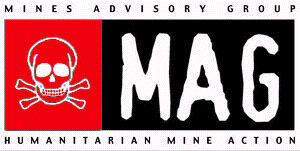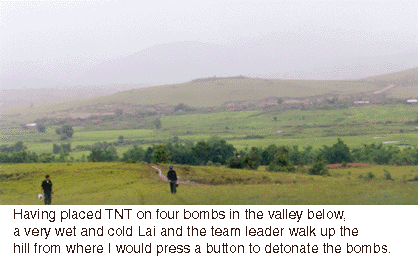These
days most people don't believe in miracles. I didn't either
until I witnessed one this past summer. It happened in Northern
Laos. Laos, is a land-locked country north of Thailand and west
of Vietnam in Southeast Asia. It is nearly the size of England
but has only about five million people (versus England's 60
million). It is a very pretty mountainous country with wild
rivers and deep forests. It also has the distinction of being
the country with the highest ratio of bombs dropped per person
of any place on earth. From 1964 to 1973 the US, in 580,344
bombing runs, dropped just over two million tons of bombs on
Laos. The idea was to stop the flow of guns and men along the
Ho Chi Minh trail from Hanoi to South Vietnam. "Collateral
damage" and "civilian casualties"--like we heard
about in the Kosovo war, was not a consideration. Everything
and everyone in Northern Laos was a target. To us the Lao people
were not quite human.
Even now no one knows how many
people were killed or the real extent of the damage, but everyone
I talked to had lost a family member in the bombing and certainly
every substantial building was destroyed. With that many bombs
dropped it's only natural that some did not explode. The US
military claims that 10% of the bombs didn't go off; other people
think that 30% of the bombs didn’t explode. But it doesn't
really matter what the numbers are: no matter how you figure
them, there are an incredible number of bombs that are waiting
for a woman gathering firewood to nudge, a farmer to strike
with his hoe, or for a child to play catch with if they are
one of the millions of baseball-shaped anti-personnel bombs
that were dropped.
In 1994 an international organization,
the England-based Mines Advisory Group, began a program to find
and explode those unexploded

bombs, what they call UXO (Unexploded Ordnance).
Last summer they asked me to help them design a database that
would keep track of how many bombs they had found and destroyed.
The 186 fields in the database formed a list of seemingly every
thing that could possibly fall from the sky. The US military
even dumped the bombs they had stockpiled from World War II.
These days the Mines Advisory Group,
or MAG, has a staff of 200 who have three basic tasks: (1) to
teach people what to do when they find a bomb, (2) to clear
(de-bomb) land where someone wants to build something and (3)
to explode bombs that people have found.
The educational component lectures,
passes out "Just say No to Bombs" T-shirts, and put
up posters to warn people not to pick up unexploded ordinance.
Earlier this year they went to a village and passed out the
T-shirts to a group of smiling children. The next day, by chance,
those same children spotted a bomb on the way home from school.
Most of the kids immediately got away from it. One boy, however,
the boy who had, ironically, sat in the front row of the bomb-awareness
class, started to play catch with the baseball-shaped bomb.
He shortly blew himself up.
Whenever someone wants to build
a building, a soccer field or make a road, they will contact
the Mines Advisory Group to come and de-bomb it. And they almost
always find bombs. A friend was staying in a guesthouse when
MAG stopped by. They found a bomb buried outside his window.
When I rode in from the airport they were working on a bomb
that someone had spotted in the ditch along the road. Once they
cleared the ground for a new school and found only three bombs.
Then the land was landscaped with truckloads of topsoil--those
truckloads contained, to everyone's horror, 35 baseball-sized
bombs. It's amazing. The clearance work is incredibly tedious.
First they survey the area and mark it off like the yard lines
of a football field. Next they, keeping a safe distance from
each other, sweep the yard lines with mine detectors. Every
bottle cap, nail, and old beer can has to be considered a live
bomb until someone proves it otherwise. The de-bombers work
in the cold rain, the hot sun, and the dirty mud, all for one
hundred dollars a month.
Education and clearance are the
boring parts of the job. The fun part is blowing stuff up that
people have found. The process begins with a MAG representative
visiting a village and asking the headman (mayor) to make a
list of the bombs that people have found. Often this is the
first contact that villages have with MAG. After the representative
checks that the bombs are actually there, he sends in a clearance
team. I went out with a clearance team one morning and watched
the woman in the above picture, Miss Lai, demonstrate her expertise.
She was one of seven people, excluding
the medic, on the team. As soon as we arrived at the site the
four sentries took off with bullhorns and walkie-talkies to
clear the area of people while the technicians strung a few
hundred meters of detonator cable from the top of a nearby hill
through the valley where a farmer had marked four bombs in his
lush pasture. As they strung the cable, they studied the ground
for even more bombs, but didn't find any. When the cable was
beside all four bombs, the team leader used his walkie-talkie
to checked in with his sentries. One

of them was hearding water buffalo out of danger, others had
told the people in near-by houses to leave. After a few minutes
they gave him the go-ahead. Miss Lai then put on protective
glasses, but no other protective clothing, and inserted a detonator
pin into a cigarette pack-sized block of TNT that the Mines
Advisory Group had bought from the Russian military "at
a very reasonable price." She then did the same thing to
the other three bombs.
It was raining and cold. I had
an umbrella; the demolition experts and the sentries had nothing.
(In Asia they've never stopped planting rice just because it's
raining--everyone somehow endures it even though they get as
cold and sick as we do.)
When the TNT was safely in place
we walked to the top of the hill from where we could see the

entire valley. The team
leader then want back to his walkie-talkie-the sentries said
that everything looked okay.
As the guest of honor, I was given the task of pressing the
button that would set of the TNT. I turned a crank that generated
a charge and when a light flashed I pressed the button. Ka-boom!
Four white puffs of smoke instantly dotted the valley. We then
did a check to make sure that the TNT had actually exploded
the bombs and not just pushed them away. It had--where the bombs
had been there was now a little crater.
To the Lao technicians and sentries
it was just another day. To me it was the most exciting thing
since the movie Armageddon staring Bruce Willis as Harry
Stamper. What, I thought, could be more fun than blowing up
old bombs?
Now let me tell you about the miracle
I saw. They don't hate us. No one I met hates us. I met soldiers
who had practically lived underground for years to escape the
bombing, people who had lived in the jungle, a woman who had,
when she was ten-years-old, walked for two weeks to reach relative
safely in Vietnam after the bombing killed her grandparents.
And no one hates us. There is a cave there where 300 people
were incinerated when it got bombed and still everyone I met
was warm and friendly. The Buddha taught that hatred does not
stop hatred, only love does. It seems to be a lesson that the
people of Northern Laos have learned very well. It’s a
miracle and something to think about at Christmas.
A few pictures
from Laos
(All pictures
were taken with my camera.) 
The chief technicians in MAG Laos
are all former British Royal Engineers (munitions experts) and
are as tough as they come: Jerry on the left occasionally finds
a style of bomb that he hasn't seen before. When I was there
he brought one back to the office and took it apart. On the
day this picture was taken, in late August, he had woken up
with malaria. That’s me in the middle. Earlier this year
Peter, on the right, caught on fire when a phosphorus bomb he
thought had been detonated exploded. Phosphorous ignites when
it comes into contact with oxygen. Quick-thinking Peter took
off his clothes and covered himself in mud until he could reach
a hospital.